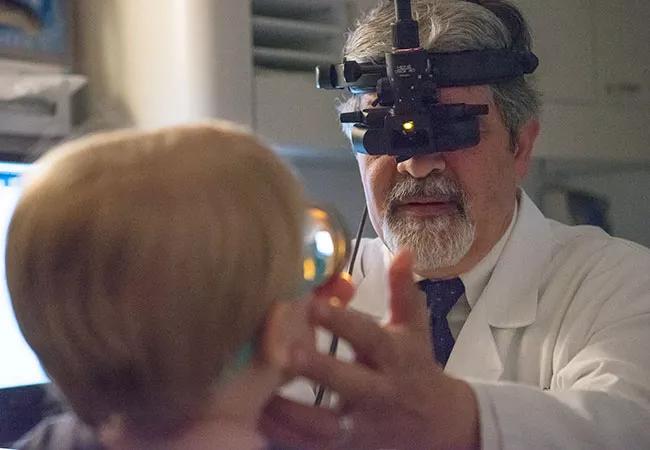Unilateral cataract surgery appears relatively safe for children aged 7-24 months

By Elias I. Traboulsi, MD, MEd and Erick D Bothun, MD
Advertisement
Cleveland Clinic is a non-profit academic medical center. Advertising on our site helps support our mission. We do not endorse non-Cleveland Clinic products or services. Policy
Influenced by the results of the Infant Aphakia Treatment Study (IATS), the management of infantile cataracts has undergone significant changes in the past two decades. A new study of surgical outcomes suggests unilateral cataract surgery appears relatively safe for children between the ages of 7 and 24 months.
Before the IATS, which involved investigators from 13 academic institutions in the United States and enrolled patients between 2004 and 2010,1 there was no agreement on the benefits of implantation of intraocular lenses (IOL) in infants under the age of 7 months, nor were there any prospective studies that analyzed possible complications thereof.
The IATS demonstrated no visual benefits of IOL implantation compared with using contact lenses to replace the natural lens of the eye after its removal. Unfortunately, infants undergoing IOL implantation had high rates of additional intraocular surgery (72%), as well as adverse events such as lens proliferation into visual axis (44%), pupillary membrane (28%), corectopia (28%), glaucoma (19%) and glaucoma suspect (9%).2
We believe the findings of the IATS have influenced most pediatric ophthalmologists to prefer contact lens care instead of IOL insertion in infants under 6 months of age.
The Toddler Aphakia and Pseudophakia Study (TAPS) study was designed to evaluate the outcomes of cataract surgery in children prior to 24 months of age and was conducted at 10 of the 13 IATS sites. It is the largest cohort of cataract outcomes in this age group.
Advertisement
Despite limitations of retrospective data including the use of nonrandomized patients and nonstandardized documentation, the close parallels between the care provided to TAPS and IATS patients allow for comparison in determining the effect of age on outcomes.
In this first report of TAPS,3 children who underwent unilateral cataract surgery with or without IOL placement during the IATS enrollment years of 2004 to 2010 were followed up, and intraoperative complications, adverse events, long-term visual acuity outcomes and incidence of strabismus were analyzed.
Fifty-six children were included with a mean postoperative follow-up of 47.6 months. Median age at cataract surgery was 13.9 months (range 7.2-22.9). Of patients in the study, 92% received a primary IOL. The only intraoperative complication was inadvertent capsular disruption in five patients (9%).
At 5 years of age, visual acuity of treated eyes was very good (> 20/40) in 11% and poor (< 20/200) in 44%. Adverse events were identified in 24%, with a 4% incidence of a glaucoma suspect status. An additional unplanned intraocular surgery occurred in 14% of children. Neither adverse events nor intraocular reoperations were more frequent in children who were operated between 7 and 12 months of age than those who had surgery at 13 to 24 months.
Although most children had IOL implantation concurrent with unilateral cataract removal, the incidence of complications, reoperations and glaucoma was low in children older than 7 months, and compared favorably to same-site IATS data for infants operated before 7 months of age.
Advertisement
Unilateral cataract surgery in infants older than 7 months appears to have a less complicated course than those younger than 7 months with fewer intraoperative complications, adverse events and reoperations and high myopic refractive shift.
The TAPS results suggest that there are no deleterious consequences of implanting intraocular lenses over the age of 7 months compared with leaving the child aphakic and wearing a contact lens.
Dr. Traboulsi is Head of the Department of Pediatric Ophthalmology and Director of the Center for Genetic Eye Diseases at Cleveland Clinic’s Cole Eye Institute. Dr. Bothun is an ophthalmologist in Mayo Clinic’s Department of Pediatric and Adolescent Medicine.
Advertisement
Advertisement

Prescribing eye drops is complicated by unknown risk of fetotoxicity and lack of clinical evidence

A look at emerging technology shaping retina surgery

A primer on MIGS methods and devices

7 keys to success for comprehensive ophthalmologists

Study is first to show reduction in autoimmune disease with the common diabetes and obesity drugs

Treatment options range from tetracycline injections to fat repositioning and cheek lift

The advanced stage of diabetic retinopathy is among the most challenging for retinal surgeons

New insights on effectiveness in patients previously treated with other anti-VEGF drugs